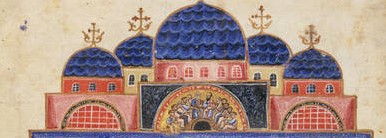DIGITAL-RESEARCH PROJECTS DIGITAL HUMANITIES

Annotating the New Testament: Codex H, Euthalian Traditions, and the Humanities
The Manuscripts’ Digital Research and Study Laboratory of the University of Athens joins this research project that is funded by an AHRC Early Career Research Grant and is directed by the Theology and Religious Studies Department at the University of Glasgow/School of Critical Studies, Glasgow, Scotland, United Kingdom. Moreover, this project, led by Dr. Garrick Allen, Senior Lecturer in Biblical Studies-New Testament at the Theology and Religious Studies Department of the University of Glasgow (Scotland, United Kingdom) and Dr. Kimberley Fowler, Assistant Professor in New Testament at the Faculty of Theology and Religious Studies of the University of Groningen (Netherlands), explores the origins and transmission of the Euthalian Apparatus, a ubiquitous and complex set of paratexts attached to the book of Acts, Paul's Letters, and the Catholic Letters in the New Testament. A major point of emphasis is on Codex H, the earliest witness to this tradition, which is preserved in Paris, Torino, Mount Athos, Kyiv, Moscow, and St. Petersburg. The project aims to digitally reassemble this manuscript as it existed in the tenth century, based on new multispectral images that will be produced by the Early Manuscripts Electronic Library (EMEL) organization.
The project’s partners are: 1) University of Glasgow/School of Critical Studies/Theology and Religious Studies Department, Glasgow, Scotland, United Kingdom (Lead Research Organisation). 2) University of Athens/Manuscripts’ Digital Research and Study Laboratory, Athens, Greece. 3) ADAPT Centre, Trinity College, Dublin, Ireland. 4) University of Turin, Turin, Italy. 5) Early Manuscripts Electronic Library. 6) Greek Orthodox Cathedral of Saint Luke in Glasgow, Scotland, United Kingdom.
As it is stated “MARK16 is a project conducted over five years (2018-2023) thanks to a PRIMA grant from the Swiss National Science Foundation and led by a team of researchers under the guidance of Claire Clivaz (PI) at the SIB Swiss Institute of Bioinformatics. MARK16 renewed the approach to the last chapter of Mark’s Gospel, by focusing on its multilingual manuscripts. The project investigated a well-known enigma of New Testament textual criticism: some manuscripts do not contain the accounts of the appearance of the risen Jesus at the end of the second Gospel. To this end, MARK16 has developed the first virtual research environment (VRE) dedicated to a biblical chapter (https://mark16.sib.swiss). This VRE makes available 61 manuscripts in 11 ancient languages with folios from Mark 16, as well as useful research resources on a multimedia platform. This digital space now enables researchers to explore the complexity of the textual tradition of the manuscripts of this gospel ending, analyzing the choices made by the various Christian groups in the early centuries of our era. . . MARK16 was overseen by an international scientific committee comprising Leif Isaksen (UK), Jennifer Knust (USA), Valérie Nicolet (FR), Laurent Romary (FR), Joseph Verheyden (BE) and Peter Williams (UK). The project team included Claire Clivaz - PI; Priscille Marshall and Mina Monier, Post-docs; Elisa Nury, Research Scientist; Silvano Aldà and Jonathan Barda, IT developers (Core-IT, SIB).”
The collaboration between the MARK16 project and the Manuscripts Digital Research and Study Laboratory (MDRSL) has been announced on the SNSF database (https://data.snf.ch/grants/grant/179755), as well as on the research blog of the group (https://claireclivaz.hypotheses.org/4155).
/i’ko.na/ Virtual Reality Research Project
This research project “focuses on exploring the multifaced and diverse aspects of imagery within the central Asterousia Mountains in the southern part of the island of Crete. Professors of Theology and Visual Arts, along with graduate students, collaborate with monks and representatives from local cultural institutions to investigate the innate human inclination to depict both visible and invisible dimensions of daily and religious life. The project places particular emphasis on documenting, promoting, and preserving the distinctive elements of local iconographic art found in the Orthodox Christian monuments of the region, thereby contributing to the digital documentation and conservation of fresco painting in central Asterousia.
Collaborators include the Manuscripts Digital Research and Study Laboratory of the University of Athens/School of Theology, the Frescos and Icon Art Laboratory of the Highest School of Fine Arts (Athens), and the LOOX.Media: Research, Innovation, and Culture Organization.
The MDRSL's role is to initiate the research on the scriptorium at the Metochion of the Three Hierarchs in the geographical area of Loussoudi of the Asterousia Mountains, utilizing modern innovative research methods of Digital Humanities+.